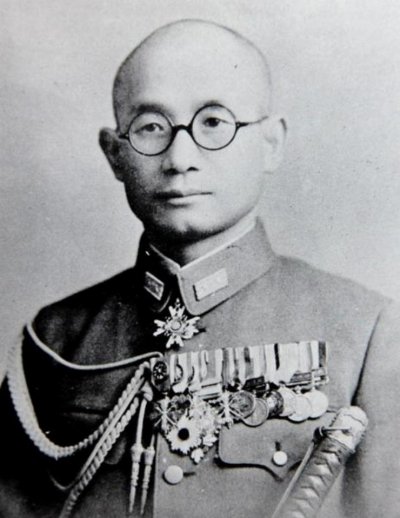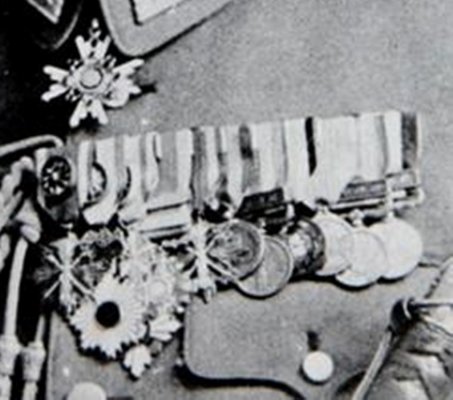
Masanobu Tsuji - Wikipedia

"May Wear Both Classes of Order of Golden Kite Simultaneously": Two Kites on One Man Chest
"Those who have received the Order of the Golden Kite, and again received a higher grade, may wear both" Imperial Edict No. 726 of June 28, 1941 “Those who have received the Order of the Golden Kite, and again received the same grade, shall wear both” Imperial Edict No. 657 of September 26...
3rd sacred treasure order.
4th kite, 4th sun, 4th clouds, 4th pillars and 5th kite orders + Showa-28, Manchurian Incident, National Foundation, 2600 anniversary, China Incident and Nomonhan Incident medals.

Obvious violations of rules of wearing.
Author of the famous

disappeared without a trace in 1961.
Article from Japan Times.
Disappearance of Masanobu Tsuji remains a mystery
BY SHIRO YONEYAMA
JUL 26, 2000
Kyodo News — An entrance ceremony for the University of Tokyo was only eight days away in April 1961 when Takeshi Tsuji, excited about starting life as a student at the nation’s most prestigious school, saw his lawmaker father off on a Southeast Asian “mission.”
But April 4, 1961, turned out to be the last time Takeshi saw his father, Masanobu Tsuji, whose whereabouts remain unknown today. He would be 98 this Oct. 11, though he was legally declared dead in 1968.
The fate of Tsuji, a staff officer in Japan’s Guangdong Army and at the Imperial General Headquarters who later became a colonel during World War II, has long been a source of curiosity in his homeland and in many parts of Asia.
One of the most controversial figures in the Imperial Japanese Army, Tsuji was a key planner and strategist in the 1939 Nomonhan Incident, in which Japanese troops were badly beaten by Soviet soldiers on the Manchurian and Mongolian frontiers.
He also had a hand in the disastrous 1942 Guadalcanal campaign, the invasion of Malaya and the capture of Singapore, before being stationed in Burma and finally Thailand.
When Japan surrendered in August 1945, Tsuji decided to flee, first pretending to be a local Buddhist monk, and later acting as an adviser to Chiang Kai-shek and his nationalist Chinese government before returning to Japan in 1947. Three years later he emerged from obscurity to become an instant celebrity.
He was easily elected to the House of Representatives from his native Ishikawa Prefecture in 1952 and switched to the House of Councilors in 1959. After 10 years in the Diet, during which he displayed nonpartisan and sometimes erratic behavior, he decided to embark on the fateful Southeast Asian mission.
Kenshiro Seki, president of a famous Japanese inn called Sekiya in the hot-spring resort of Katayamazu in Ishikawa Prefecture, remembers meeting Tsuji in his office one day before his departure for Southeast Asia.
“I’m going to Laos on orders from Prime Minister (Hayato) Ikeda,” Seki, 58, quoted Tsuji as telling him and his mother, Tami, 39 years ago.
Seki said Tsuji patronized his inn whenever the lawmaker returned to his constituency in the prefecture on the Sea of Japan coast. He said Tsuji needed such moments of safety and comfort after nearly five years on the run as a potential war criminal.
Takeshi, 57, speculated in an interview with Kyodo News that his father felt he had fulfilled his parental responsibility because his son had passed the rigorous university entrance exam and would be capable of supporting himself after graduation.
Masayoshi Tsuji, 85, is a younger brother of Tsuji and the only surviving member of the Tsuji clan from the village of Imadachi near another hot-spring resort, Yamanaka, in the prefecture.
Masayoshi, also a former military officer who ran a stationery shop in Komatsu, Ishikawa Prefecture, before his retirement, had always believed his elder brother would return safely, until a few years ago.
He still keeps a postcard from his brother from Vientiane dated April 20, 1961. “I traveled around Southeast Asia with a Buddha statue,” it says. “I saw Laos. War and festivals are taking place at the same time and in the same place.”
The postcard went on to say he would return to his hometown in June to visit the grave of their younger brother, Tadashi, another military officer killed in action during the war. Tsuji also asked Masayoshi not to tell others about his clandestine trip.
“I think he is already dead. I thought he would live until 90,” Masayoshi said at his home in suburban Komatsu.
Eko Hata, chief priest of Hoshoji Temple in Tokyo’s Suginami Ward, recalled, “I thought it was an almost suicidal act to go to Laos and further north after crossing the Mekong River in the middle of the rainy season,” when told of his wartime boss’ disappearance in 1961. Laos at the time was in the middle of civil war.
Hata, 74, was one of seven priests-turned-soldiers who Col. Tsuji agreed to bring along with him on his bid to evade arrest by victorious British troops in Bangkok in the summer of 1945.
Hata, whose former name was Takashi Fukuzawa, said in an interview at his Tokyo temple that he and the other six decided to go into hiding with Tsuji because “life as a prisoner of war would be the same anywhere, and we felt he (Tsuji) would somehow manage to flee.”
The seven young priests, masquerading as Thai monks, were later captured, but Tsuji indeed fled, starting life as a fugitive that took him to Vientiane, Hanoi, China’s Chongqing and Nanjing before secretly arriving from Shanghai at Sasebo, Nagasaki Prefecture, as “a professor of Beijing University” in May 1947.
“As I placed my first step upon the soil of Japan, I quietly picked up a handful of earth, unnoticed by the others, and smelt its sweetness. It was the first smell of my motherland in six years,” Tsuji wrote in his best-selling “Underground Escape — 7,500 Miles in Disguise.”
One of the first places he visited upon returning to Japan was Hata’s temple in a quiet Tokyo residential area, which Hata said was free from police surveillance.
Tsuji stopped hiding after the U.S. ended his designation as a wanted war criminal on New Year’s Day 1950.
After writing a number of best sellers, including “Nomonhan” and “Guadalcanal,” Tsuji turned to politics. He was initially elected to the Lower House as an independent and subsequently joined the Japan Democratic Party and the Liberal Democratic Party, from which he was expelled in 1959 for insubordination and criticizing Prime Minister Nobusuke Kishi, a former Class A war criminal, for corruption.
Tsuji’s military and political career has fascinated many young men, one of whom was a Waseda University student named Yoshiro Mori.
